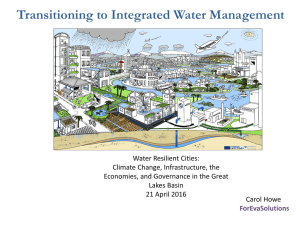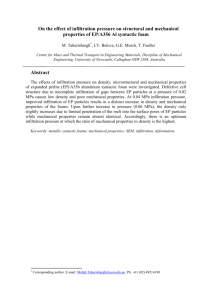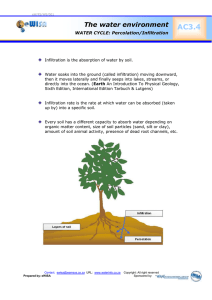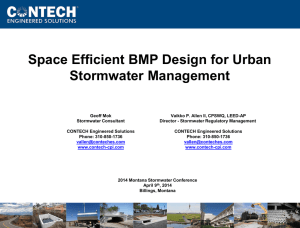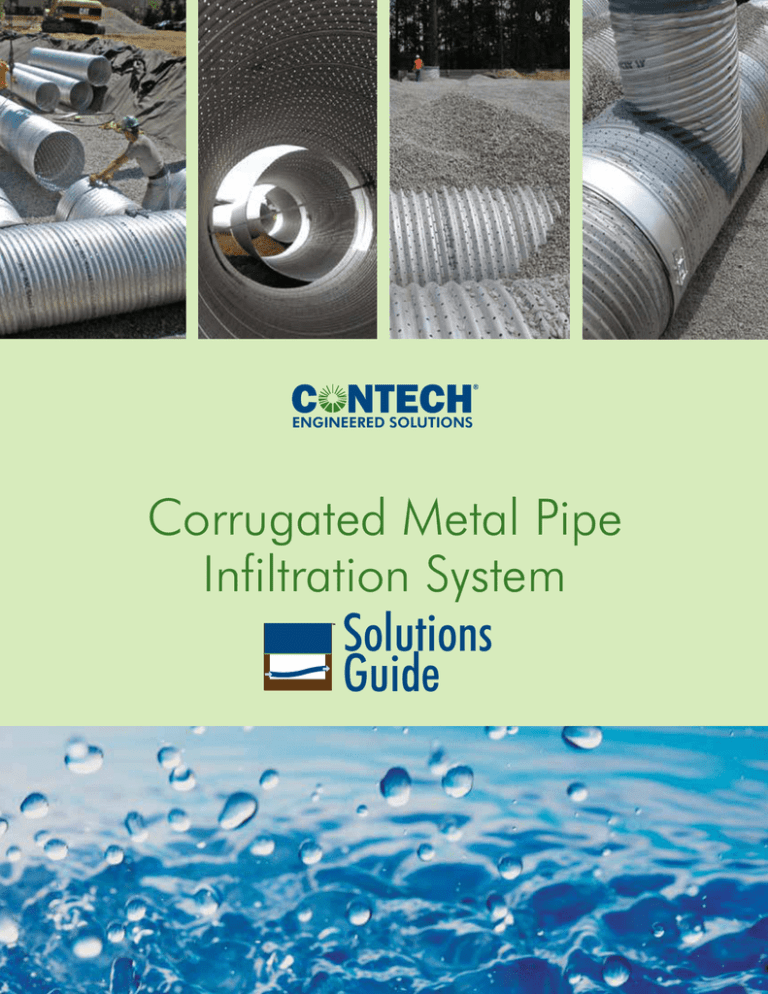
ENGINEERED SOLUTIONS
Corrugated Metal Pipe
Infiltration System
Solutions
Guide
Stormwater Solutions from Contech
Selecting the Right Stormwater Solution Just Got Easier...
It’s simple to choose the right stormwater solution to achieve your goals with
the Contech Stormwater Solutions Staircase. First, select the runoff reduction
practices that are most appropriate for your site, paying particular attention
to pretreatment needs. If the entire design storm cannot be retained, select
a treatment best management practice (BMP) for the balance. Finally, select
a detention system to address any outstanding downstream erosion.
Learn more about all of our stormwater
technologies at www.ContechES.com/s t o rm wat e r
© 2015 Contech Engineered Solutions LLC
DYODS
D esign Y our O wn D etention
The Contech Design Your Own Detention System
(DYODS®) tool fully automates the layout process
for stormwater detention and infiltration systems
and produces CAD and PDF files that can be used
for creating plans and specs, and for estimating
total installed costs.
To use the Design Your Own Detention
or Infiltration System tool, visit:
www.ContechES.com/d y o d s
2
or
I nfiltration S ystem
Subsurface Infiltration as a Stormwater Management Strategy
The only sure way to eliminate stormwater pollution is to
eliminate stormwater runoff. In recognition of this fact,
Green Infrastructure and Low Impact Development based
stormwater management regulations prioritizing runoff
reduction have proliferated throughout the United States.
Where site conditions allow, infiltration is typically the most
cost effective and reliable runoff reduction approach. In
urban environments where there are competing demands
for land, subsurface infiltration can provide many of the
benefits of landscape based systems but without requiring
dedicated land area. Infiltration systems are commonly
LID benefits include runoff volume reduction, peak flow control,
ground water recharge, and water quality improvement.
comprised of a pretreatment component designed to
remove sediment, trash, and oil, followed by plastic, metal
or concrete storage units surrounded by permeable stone
creating a high voids storage gallery. Infiltration systems
are typically designed to support vehicular loading and to
withstand lateral pressures from surrounding soil that allows
the overlying land to be used for virtually any non-building
application.
Subsurface infiltration meets the objectives
of LID by reducing runoff with the added
benefit of saving land space in urban
environments.
CMP infiltration is used at Pitzer College in Claremont, California.
Learn more at www.ContechES.com/cmp-detention
3
CMP – the “Go To” Material for Subsurface Infiltration
The purpose of the storage vessel is to hold stormwater
runoff underground while allowing it to infiltrate the
surrounding soil. For the majority of applications, corrugated
metal pipe (CMP) is the “go to” material for subsurface
infiltration.
• 75+ year service life guidance for certain materials/
coatings in recommended environments.*
• Various pipe coatings and materials are available to
accommodate site-specific needs: Aluminized Steel Type
2 (ALT2), Galvanized, CORLIX® Aluminum, and Polymer
Coated.
• Wide range of gages, corrugations, and shapes, in
diameters 12” – 144”.
• Pipe can be fully or partially perforated for infiltration,
retention, or groundwater recharge applications.
• Custom access risers and manifolds provide direct
access for maintenance.
• Outlet control devices can be incorporated within the
system, eliminating the need for a separate structure.
• Customizable - a variety of fittings allow CMP to match
most layout configurations.
• May be designed for heavy loading and high maximum
cover.
• Contributes to LEED points.
CMP can be laid out in configurations
not achievable with other materials.
• Available locally; quick turnaround time.
• The most economical installed solution.
With its low cost, a wide variety of diameters,
layout configurations, and materials, no other
material can match CMP’s flexibility and versatility.
*
4
Service life guidance provided by National Corrugated Steel Pipe
Association (NCSPA) and/or AK Steel Corporation. See NCSPA.org website
or consult your engineer of record for additional information on service
life, recommended environments and field studies on various materials and
coatings. Corrosive environments, such as seawater and road/de-icing salt
infiltration, and other environments with pH and resistivity outside of the
recommended range may cause premature corrosion and reduce actual
service life. Because site conditions vary, Contech does not guaranty or
warrant service life guidance for materials and coatings
A wide range of CMP diameters and coatings are available
to meet site specific needs.
Addressing the Question of Longevity
Some engineers are hesitant to use corrugated metal pipe (CMP)
for infiltration because they have heard about CMP drainage
culverts that have corroded due to abrasion. Factors affecting
longevity differ between culvert and infiltration applications.
Culverts experience high velocity flows carrying abrasive sediment,
which can wear off galvanized coatings used in older CMP
culverts. Infiltration systems are designed for storage rather than
conveyance, so velocity and abrasive forces are minimized. In
addition, improved CMP coatings, such as Aluminized Type 2
(ALT2), are more abrasion resistant and have demonstrated
superior in-ground performance against abrasion in long-
CMP has a proven service life
term durability studies. Field studies also have indicated that
ALT2 coating may extend service life in wider pH and resistivity
ranges than galvanized coatings. Confirming and maintaining
recommended environmental conditions helps ensure system
longevity projected by the long term studies. Finally, properly
designed infiltration systems include pretreatment, flow control and
a stone backfill envelope that can reduce exposure to abrasion.
• National Corrugated Steel Pipe Association (NCSPA) service
life guidance of 75+ years for certain materials/coatings in
recommended environments.
• CMP infiltration systems can be designed to meet HS-20
or greater load requirements with proper
depths of cover.
• With low flows, CMP infiltration systems have
little susceptibility to abrasion inside the pipe
that holds stormwater runoff.
Learn more about the durability of steel through
the recent NCSPA ALT2 Study -
w w w. n c s p a . o rg
• Various pipe coatings and materials are
available to accommodate site-specific needs:
Aluminized Steel Type 2 (ALT2), Galvanized, CORLIX® Aluminum, and Polymer Coated.
• CMP infiltration systems are to be surrounded by clean crushed rock to provide increased storage capacity
and reduce contact with native soils. The entire system may be wrapped with fabric or liner on the sides
and top to help further reduce contact with native soils.
• CMP infiltration systems may be used in wide range of recommended environments. AK Steel Corporation’s
field studies and technical guidance indicate 75 year service life guidance for 16 gage Alt2 for pH of 5-9
and resistivity greater than 1,500 ohm-cm and 100 year service life guidance for 16 gage Alt2 for pH of
6-8 and resistivity greater than 5,000 ohm-cm.
• Corrosive environments, such as seawater and road/de-icing salt infiltration, acidic minewater, and sanitary
sewage, and other environments with pH and resistivity outside of the recommended range may cause
premature corrosion and reduce actual service life.
• Infiltration systems are to be inspected and maintained in accordance with Contech’s guidelines. See CMP
Detention/Infiltration Design Guide for additional information on CMP infiltration systems.
Learn more at www.ContechES.com/cmp-detention
5
Maximizing Vertical Space: Every Inch Counts
One of the most overlooked advantages of CMP is its
ability to maximize vertical storage space.
Increasing the depth of a CMP infiltration system
allows for more water storage in the same footprint.
For example, doubling the diameter of pipe yields
four times as much storage volume in the pipe. This
provides a significant cost savings per cubic foot of
storage. In addition, more vertical storage space
means a smaller footprint, less excavation, and lower
project costs.
96” diameter - 50.2 ft³/ft
Contech’s Corrugated Metal Pipe Detention
systems maximize vertical storage space.
48” diameter - 12.5 ft³/ft
2x the diameter - 4x the storage
Sizing
Round Pipe – CMP
Diameter
(inches)
6
6-in to 144-in
Volume
(ft3/ft)
Min. Cover Height
Diameter
(inches)
Volume
(ft3/ft)
Min. Cover Height
12
.78
12”
78
33.2
12”
15
1.22
12”
84
38.5
12”
18
1.76
12”
90
44.2
12”
21
2.40
12”
96
50.3
12”
24
30
36
3.14
4.9
7.1
12”
12”
12”
102
108
114
56.8
63.6
70.9
18”
18”
18”
42
9.6
12”
120
78.5
18”
48
54
60
66
72
12.6
15.9
19.6
23.8
28.3
12”
12”
12”
12”
12”
126
132
138
144
86.6
95.0
103.9
113.1
18”
18”
18”
18”
The Need for Effective Pretreatment
Infiltration systems have multiple components, and one
of the most important is pretreatment. The purpose of a
pretreatment device is to prolong the life of the infiltration
system by removing debris and sediment that can collect on
the invert and within the stone backfill voids. Pretreatment
will maintain the efficiency of an infiltration system as well
as extend the life cycle, therefore preventing a premature
replacement. Pretreatment also offers these additional
benefits:
• Easier to clean and maintain compared to the
infiltration system itself.
• Cost savings due to the extended service life of the
system.
• Removing trash and debris protects downstream outlet
control structures from clogging.
Pretreatment Design Considerations
When choosing a pretreatment system, it is important to
consider the following:
• Downstream outlet control structures may require
protection from a pretreatment device that screens
trash and debris.
• Pretreatment system selection depends on pollutant
targets. Trash, debris, and larger particles can be
removed with hydrodynamic separators. Removing
high percentages of fine particles and associated heavy
metals and nutrients requires filtration.
• Reduced long term maintenance or replacement cost
of the infiltration system can help justify pretreatment
construction costs.
• Inlet and pipe layout will influence the number and
type of pretreatment systems used. A combination of
different systems may be appropriate for the various
inlet locations and flows.
Pretreatment systems that are easy to maintain
and do not rely on the use of geotextile fabric are
preferred.
Learn more at www.ContechES.com/cmp-detention
7
7
Pretreatment Options
Contech offers a number of pretreatment options, all of which
will extend the life of subsurface infiltration systems and improve
water quality. The type of system chosen will depend on a
number of factors including footprint, soil conditions, local
regulations, and the desired level of pretreatment.
CDS provides direct access to cleaning, and the
built-in high flow bypass weir eliminates the need
for a separate bypass structure.
Hydrodynamic Separation
Hydrodynamic Separation (HDS) provides a basic level of pretreatment
by capturing and retaining trash and debris, sediment, and oil from
stormwater runoff.
CDS®
The CDS uses a combination of swirl concentration and indirect
screening and is the only non-blocking screening technology available
in an HDS system.
Filtration
Filtration provides a higher level of pretreatment and improved water
quality by removing trash and debris, oil, fine solids, and dissolved
pollutants such as metals, hydrocarbons, and nutrients.
Filterra® Bioretention System
Filterra is an engineered bioretention system that has been optimized for
high volume/flow treatment and high pollutant removal.
The Stormwater Management StormFilter®
The StormFilter system is comprised of a structure that houses
rechargeable, media-filled cartridges. The media can be customized to
target site-specific pollutants.
Jellyfish® Filter
The Jellyfish filter uses membrane filtration in a compact footprint to
remove a high level and a wide variety of stormwater pollutants such as
fine particulates, oil, trash and debris, metals, and nutrients.
8
Alternative Materials for Subsurface Infiltration
There may be instances where alternative materials are
needed for subsurface infiltration due to site specific needs.
Plastic Chambers
Concrete Structures/Vaults
Some concrete structures and vaults are best suited for high
loading applications such as railroads or airports. Concrete
units are also ideal in corrosive environments or areas with
Plastic chambers are best suited to shallow depth
applications; minimum cover is 18 inches, and maximum
high salinity. Some benefits of concrete structures are:
• Wide range of spans and heights.
cover is 96 inches. Some benefits of chambers are:
• Chambers may be beneficial for sites with limited vertical
storage.
• Lightweight and installed by hand.
• Heavy equipment is not required to set units into place.
• Greater underground infiltration storage in a smaller
footprint.
• Ample and easy maintenance access.
• Fast installation.
• Centralized stocking locations for short lead times.
Learn more at www.ContechES.com/cmp-detention
9
Project Profiles: CMP Infiltration Systems in Action
Edie and Lew Wasserman Building, UCLA
Westwood, California
• The new six-story, 100,000 square foot Edie and Lew
Wasserman Building was built on a very dense site that
needed to meet sustainability requirements.
• The design needed to maximize infiltration volume, match
existing inverts, and work around existing utilities.
• The stormwater management systems included a CDS
pretreatment system and a CMP infiltration system using
57’ of 72” perforated CMP.
• Perforated CMP was selected to avoid utilities, minimize
excavation, meet the City of LA LID requirements, contribute
to the building’s LEED certification, and to provide space
for the buildings “outdoor room” and gardens.
Creative Office Space
El Segundo, California
• A stormwater infiltration solution was needed for a new
group of office buildings.
• The owner wanted to maximize the use of the parking
area in the urban setting.
• The site had a tight footprint and multiple utility
constraints, requiring the design of five separate systems.
• A total of 860 LF of perforated CMP was installed
providing of 25,265 CF of storage.
• Perforated CMP was selected for its design flexibility, cost
effectiveness, and ease of installation.
City Center Regional Stormwater Facility
Mountlake Terrace, Washington
• The city of Mountlake Terrace, Washington needed a new
stormwater retention facility to provide stormwater treatment
and downstream flood control.
• There was limited footprint for 80,000 CF of runoff, and
the system was required to be very deep, with about 15’ of
cover.
• Engineers designed a system consisting of a CDS
pretreatment system in front of 800 linear feet of 120”
diameter, perforated, aluminized type 2 CMP that allows the
runoff to slowly infiltrate the surrounding soil.
• Perforated CMP was selected for its ability to accommodate
the deep bury, the relatively small footprint, and cost
effectiveness.
10
The Right Partner Can Make All the Difference
Regardless of your project’s objectives and constraints, our team of stormwater design engineers, regulatory managers, and
local stormwater consultants are here to provide you with expert advice and assistance. If your goal is to eliminate or detain
runoff, you can rely on Contech for a wide range of subsurface infiltration, detention, and rainwater harvesting solutions. If
treatment is needed, our landscape-based biofiltration or subsurface filtration designs can fit into virtually any site and can be
tailored to address specific pollutants.
At every stage of your project, count on Contech to provide engineering services including:
• Regulatory guidance and permitting assistance
• Preliminary standard details and/or site specific final CAD drawings and specifications
• Low Impact Development design assistance
• Engineering calculations for hydraulics/hydrology, rainwater harvesting, and detention/retention
• Online “Design Your Own” tools
• Review of preliminary site design, feasibility screening, and layout assistance
• Value engineering – cost estimates and options analysis
• Pre-construction support, project scheduling, and contractor coordination
• Installation and construction support
• Maintenance support:
»» Guidance manuals
»» Demonstrations
»» Qualified contractor identification
The result: an efficient design process, the right product, greater land space savings, and faster permitting. The entire
Contech stormwater team welcomes the opportunity to work with you on your stormwater projects.
To get started, please visit www.conteches.com/localresources or call us at 800-338-1122.
Learn more at www.ContechES.com/cmp-detention
11
Dig Deeper
Links to Stormwater Tools:
Find all the information you need at www.ContechES.com,
including field and laboratory test results, approvals,
brochures, design guides, standard details, and
specifications within the product section of our site.
To use the Land Value Calculator, visit:
www.ContechES.com/
(Look under the Stormwater Management section to download the Land Value Calculator)
lvc
Connect with Us
To use the Design Your Own Detention System tool, visit:
www.ContechES.com/
We're here to make your job easier – and that includes
being able to get in touch with us when you need to.
Go to www.ContechES.com/
dyods
ConnectWithContech.
To use the Design Your Own Hydrodynamic Separator tool,
visit: www.ContechES.com/
While you’re there, be sure to check out our upcoming
seminar schedule or request an in-house technical
presentation.
dyohds
To use the Rainwater Harvesting Runoff Reduction Calculator
tool, visit: www.ContechES.com/
-
Start a Project
r w h c a l c u l at o r
If you are ready to begin a project, contact your local
representative to get started. Or you can check out our
design toolbox for all our online resources at
www.ContechES.com/
To use the LID Site Planner , visit:
www.ContechES.com/
LIDsiteplanner
designtoolbox.
COMPLETE SITE SOLUTIONS
ENGINEERED SOLUTIONS
Treatment Solutions
Pipe Solutions
Structures Solutions
Helping to satisfy stormwater
management requirements on
land development projects
•Stormwater Treatment
•Detention/Infiltration
•Rainwater Harvesting
•Biofiltration/Bioretention
Meeting project needs for durability,
hydraulics, corrosion resistance,
and stiffness
• Corrugated Metal Pipe (CMP)
• Steel Reinforced Polyethylene (SRPE)
• High Density Polyethylene (HDPE)
• Polyvinyl Chloride (PVC)
Providing innovative options and
support for crossings, culverts,
and bridges
•Plate, Precast & Truss bridges
•Hard Armor
•Retaining Walls
•Tunnel Liner Plate
NOTHING IN THIS CATALOG SHOULD BE CONSTRUED AS A WARRANTY. APPLICATIONS SUGGESTED HEREIN
ARE DESCRIBED ONLY TO HELP READERS MAKE THEIR OWN EVALUATIONS AND DECISIONS, AND ARE
NEITHER GUARANTEES NOR WARRANTIES OF SUITABILITY FOR ANY APPLICATION. CONTECH MAKES NO
WARRANTY WHATSOEVER, EXPRESS OR IMPLIED, RELATED TO THE APPLICATIONS, MATERIALS, COATINGS,
OR PRODUCTS DISCUSSED HEREIN. ALL IMPLIED WARRANTIES OF MERCHANTABILITY AND ALL IMPLIED
WARRANTIES OF FITNESS FOR ANY PARTICULAR PURPOSE ARE DISCLAIMED BY CONTECH. SEE CONTECH’S
CONDITIONS OF SALE (AVAILABLE AT WWW.CONTECHES.COM/COS) FOR MORE INFORMATION.
Get Social With Us!
CMP Infiltration Bro (5M as of 1/15) PDF 8/16
ENGINEERED SOLUTIONS
©2016 Contech Engineered Solutions LLC
800-338-1122 | www.ContechES.com
All Rights Reserved. Printed in the USA.
We print our brochures entirely on Forest
Stewardship Council certified paper. FSC
certification ensures that the paper in
our brochures contain fiber from wellmanaged and responsibly harvested
forests that meet strict environmental and
socioeconomic standards.
FSC





